Tuberculosis: Prevention, Diagnosis, and Management in Global Health
VerifiedAdded on 2022/09/15
|6
|976
|25
Report
AI Summary
This report addresses Tuberculosis (TB) as a significant global health issue, examining its prevalence in the United States and worldwide. The report explores contributing factors such as proximity to infectious cases, malnutrition, diabetes, and healthcare worker exposure. It details prevention strategies including the BCG vaccine and TB education, along with the signs and symptoms of active TB. Various diagnostic tests are discussed, alongside the role and management strategies of advanced practice nursing, including medication adherence, contact tracing, and public awareness. The report concludes by emphasizing the continued need for support for nurses and healthcare professionals in their efforts to manage and prevent the spread of TB. References from scholarly sources are included to support the information provided.

Running Head: TUBERCULOSIS
TUBERCULOSIS
Name
Professor
Institution
Course
Date
TUBERCULOSIS
Name
Professor
Institution
Course
Date
Paraphrase This Document
Need a fresh take? Get an instant paraphrase of this document with our AI Paraphraser
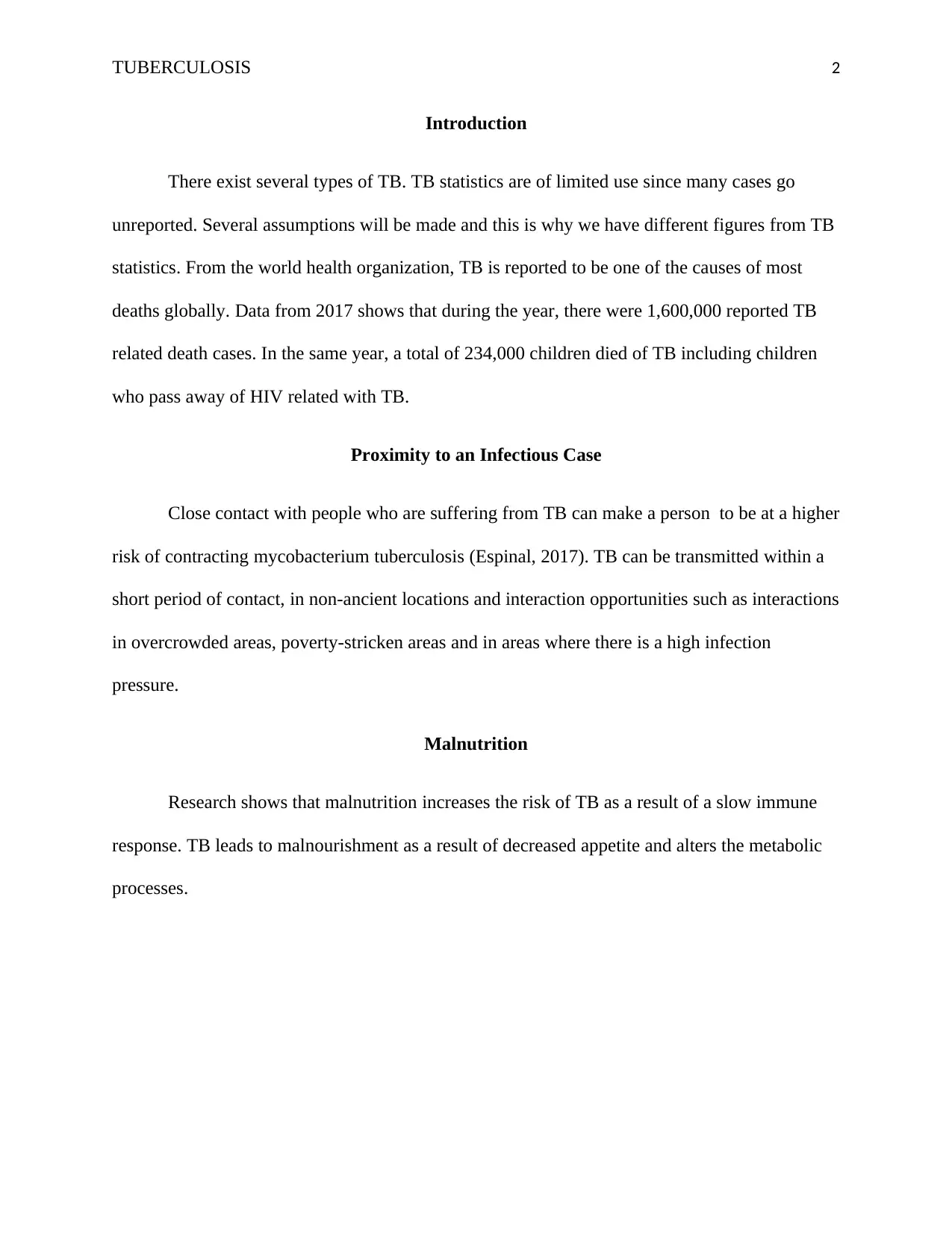
TUBERCULOSIS 2
Introduction
There exist several types of TB. TB statistics are of limited use since many cases go
unreported. Several assumptions will be made and this is why we have different figures from TB
statistics. From the world health organization, TB is reported to be one of the causes of most
deaths globally. Data from 2017 shows that during the year, there were 1,600,000 reported TB
related death cases. In the same year, a total of 234,000 children died of TB including children
who pass away of HIV related with TB.
Proximity to an Infectious Case
Close contact with people who are suffering from TB can make a person to be at a higher
risk of contracting mycobacterium tuberculosis (Espinal, 2017). TB can be transmitted within a
short period of contact, in non-ancient locations and interaction opportunities such as interactions
in overcrowded areas, poverty-stricken areas and in areas where there is a high infection
pressure.
Malnutrition
Research shows that malnutrition increases the risk of TB as a result of a slow immune
response. TB leads to malnourishment as a result of decreased appetite and alters the metabolic
processes.
Introduction
There exist several types of TB. TB statistics are of limited use since many cases go
unreported. Several assumptions will be made and this is why we have different figures from TB
statistics. From the world health organization, TB is reported to be one of the causes of most
deaths globally. Data from 2017 shows that during the year, there were 1,600,000 reported TB
related death cases. In the same year, a total of 234,000 children died of TB including children
who pass away of HIV related with TB.
Proximity to an Infectious Case
Close contact with people who are suffering from TB can make a person to be at a higher
risk of contracting mycobacterium tuberculosis (Espinal, 2017). TB can be transmitted within a
short period of contact, in non-ancient locations and interaction opportunities such as interactions
in overcrowded areas, poverty-stricken areas and in areas where there is a high infection
pressure.
Malnutrition
Research shows that malnutrition increases the risk of TB as a result of a slow immune
response. TB leads to malnourishment as a result of decreased appetite and alters the metabolic
processes.
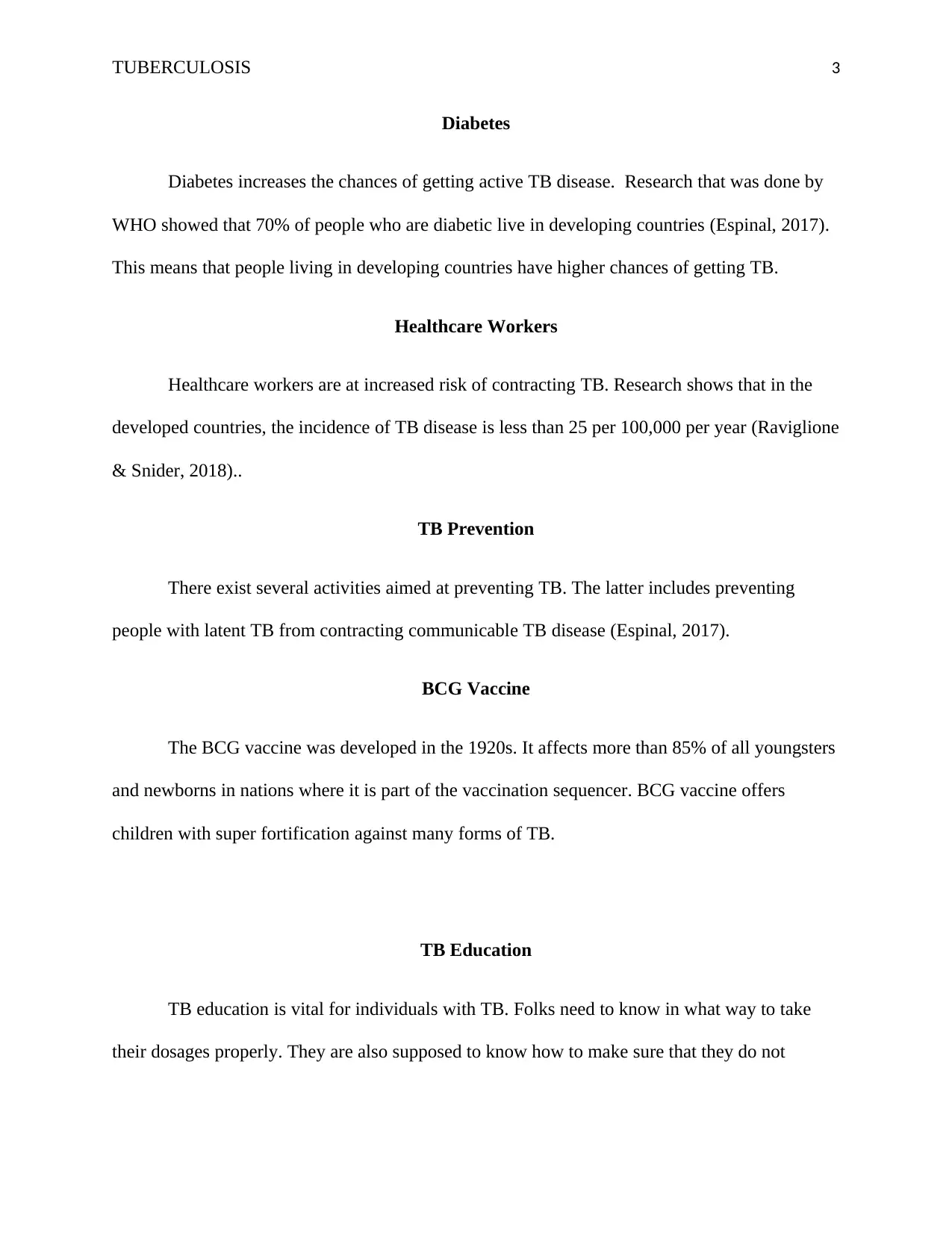
TUBERCULOSIS 3
Diabetes
Diabetes increases the chances of getting active TB disease. Research that was done by
WHO showed that 70% of people who are diabetic live in developing countries (Espinal, 2017).
This means that people living in developing countries have higher chances of getting TB.
Healthcare Workers
Healthcare workers are at increased risk of contracting TB. Research shows that in the
developed countries, the incidence of TB disease is less than 25 per 100,000 per year (Raviglione
& Snider, 2018)..
TB Prevention
There exist several activities aimed at preventing TB. The latter includes preventing
people with latent TB from contracting communicable TB disease (Espinal, 2017).
BCG Vaccine
The BCG vaccine was developed in the 1920s. It affects more than 85% of all youngsters
and newborns in nations where it is part of the vaccination sequencer. BCG vaccine offers
children with super fortification against many forms of TB.
TB Education
TB education is vital for individuals with TB. Folks need to know in what way to take
their dosages properly. They are also supposed to know how to make sure that they do not
Diabetes
Diabetes increases the chances of getting active TB disease. Research that was done by
WHO showed that 70% of people who are diabetic live in developing countries (Espinal, 2017).
This means that people living in developing countries have higher chances of getting TB.
Healthcare Workers
Healthcare workers are at increased risk of contracting TB. Research shows that in the
developed countries, the incidence of TB disease is less than 25 per 100,000 per year (Raviglione
& Snider, 2018)..
TB Prevention
There exist several activities aimed at preventing TB. The latter includes preventing
people with latent TB from contracting communicable TB disease (Espinal, 2017).
BCG Vaccine
The BCG vaccine was developed in the 1920s. It affects more than 85% of all youngsters
and newborns in nations where it is part of the vaccination sequencer. BCG vaccine offers
children with super fortification against many forms of TB.
TB Education
TB education is vital for individuals with TB. Folks need to know in what way to take
their dosages properly. They are also supposed to know how to make sure that they do not
⊘ This is a preview!⊘
Do you want full access?
Subscribe today to unlock all pages.

Trusted by 1+ million students worldwide
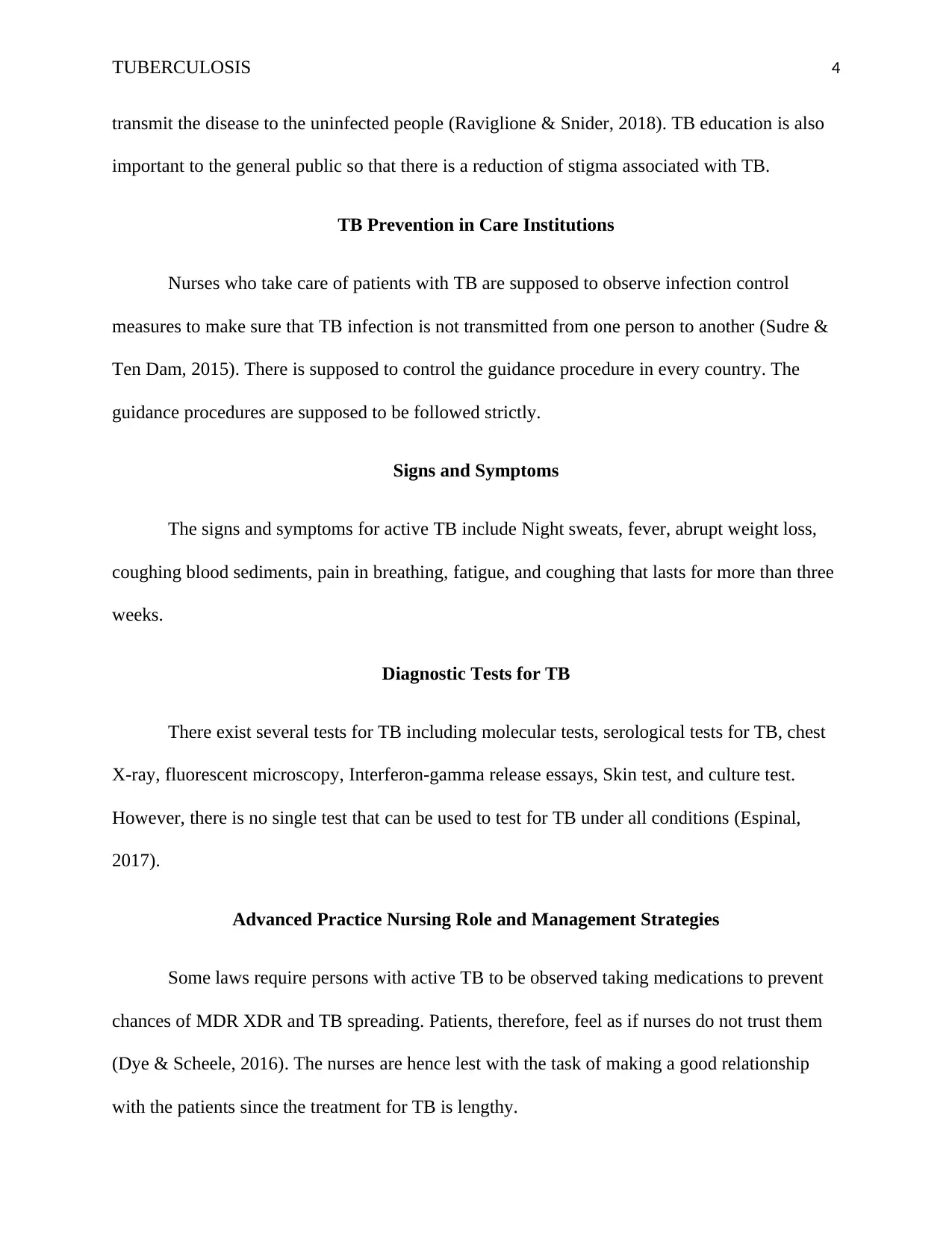
TUBERCULOSIS 4
transmit the disease to the uninfected people (Raviglione & Snider, 2018). TB education is also
important to the general public so that there is a reduction of stigma associated with TB.
TB Prevention in Care Institutions
Nurses who take care of patients with TB are supposed to observe infection control
measures to make sure that TB infection is not transmitted from one person to another (Sudre &
Ten Dam, 2015). There is supposed to control the guidance procedure in every country. The
guidance procedures are supposed to be followed strictly.
Signs and Symptoms
The signs and symptoms for active TB include Night sweats, fever, abrupt weight loss,
coughing blood sediments, pain in breathing, fatigue, and coughing that lasts for more than three
weeks.
Diagnostic Tests for TB
There exist several tests for TB including molecular tests, serological tests for TB, chest
X-ray, fluorescent microscopy, Interferon-gamma release essays, Skin test, and culture test.
However, there is no single test that can be used to test for TB under all conditions (Espinal,
2017).
Advanced Practice Nursing Role and Management Strategies
Some laws require persons with active TB to be observed taking medications to prevent
chances of MDR XDR and TB spreading. Patients, therefore, feel as if nurses do not trust them
(Dye & Scheele, 2016). The nurses are hence lest with the task of making a good relationship
with the patients since the treatment for TB is lengthy.
transmit the disease to the uninfected people (Raviglione & Snider, 2018). TB education is also
important to the general public so that there is a reduction of stigma associated with TB.
TB Prevention in Care Institutions
Nurses who take care of patients with TB are supposed to observe infection control
measures to make sure that TB infection is not transmitted from one person to another (Sudre &
Ten Dam, 2015). There is supposed to control the guidance procedure in every country. The
guidance procedures are supposed to be followed strictly.
Signs and Symptoms
The signs and symptoms for active TB include Night sweats, fever, abrupt weight loss,
coughing blood sediments, pain in breathing, fatigue, and coughing that lasts for more than three
weeks.
Diagnostic Tests for TB
There exist several tests for TB including molecular tests, serological tests for TB, chest
X-ray, fluorescent microscopy, Interferon-gamma release essays, Skin test, and culture test.
However, there is no single test that can be used to test for TB under all conditions (Espinal,
2017).
Advanced Practice Nursing Role and Management Strategies
Some laws require persons with active TB to be observed taking medications to prevent
chances of MDR XDR and TB spreading. Patients, therefore, feel as if nurses do not trust them
(Dye & Scheele, 2016). The nurses are hence lest with the task of making a good relationship
with the patients since the treatment for TB is lengthy.
Paraphrase This Document
Need a fresh take? Get an instant paraphrase of this document with our AI Paraphraser
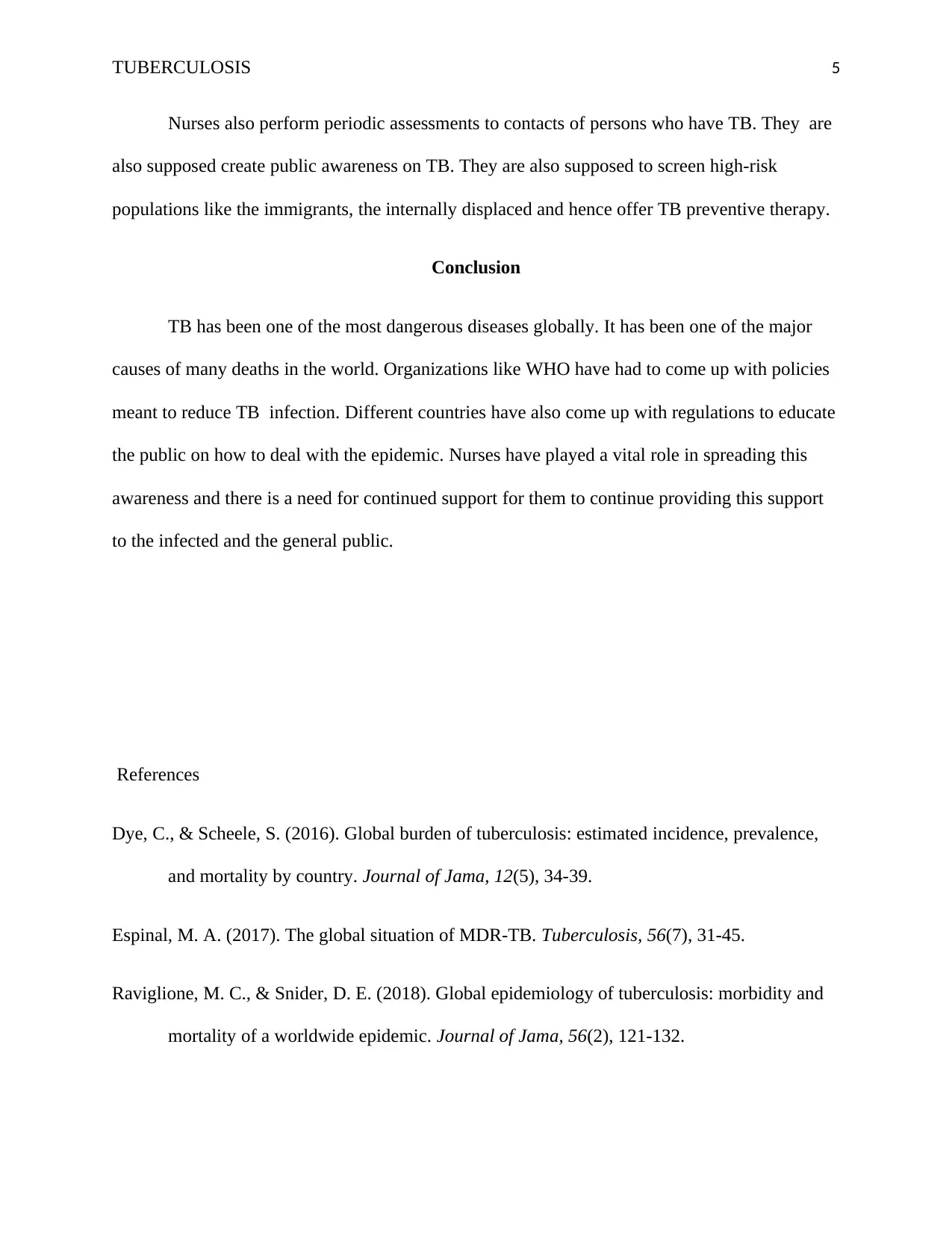
TUBERCULOSIS 5
Nurses also perform periodic assessments to contacts of persons who have TB. They are
also supposed create public awareness on TB. They are also supposed to screen high-risk
populations like the immigrants, the internally displaced and hence offer TB preventive therapy.
Conclusion
TB has been one of the most dangerous diseases globally. It has been one of the major
causes of many deaths in the world. Organizations like WHO have had to come up with policies
meant to reduce TB infection. Different countries have also come up with regulations to educate
the public on how to deal with the epidemic. Nurses have played a vital role in spreading this
awareness and there is a need for continued support for them to continue providing this support
to the infected and the general public.
References
Dye, C., & Scheele, S. (2016). Global burden of tuberculosis: estimated incidence, prevalence,
and mortality by country. Journal of Jama, 12(5), 34-39.
Espinal, M. A. (2017). The global situation of MDR-TB. Tuberculosis, 56(7), 31-45.
Raviglione, M. C., & Snider, D. E. (2018). Global epidemiology of tuberculosis: morbidity and
mortality of a worldwide epidemic. Journal of Jama, 56(2), 121-132.
Nurses also perform periodic assessments to contacts of persons who have TB. They are
also supposed create public awareness on TB. They are also supposed to screen high-risk
populations like the immigrants, the internally displaced and hence offer TB preventive therapy.
Conclusion
TB has been one of the most dangerous diseases globally. It has been one of the major
causes of many deaths in the world. Organizations like WHO have had to come up with policies
meant to reduce TB infection. Different countries have also come up with regulations to educate
the public on how to deal with the epidemic. Nurses have played a vital role in spreading this
awareness and there is a need for continued support for them to continue providing this support
to the infected and the general public.
References
Dye, C., & Scheele, S. (2016). Global burden of tuberculosis: estimated incidence, prevalence,
and mortality by country. Journal of Jama, 12(5), 34-39.
Espinal, M. A. (2017). The global situation of MDR-TB. Tuberculosis, 56(7), 31-45.
Raviglione, M. C., & Snider, D. E. (2018). Global epidemiology of tuberculosis: morbidity and
mortality of a worldwide epidemic. Journal of Jama, 56(2), 121-132.
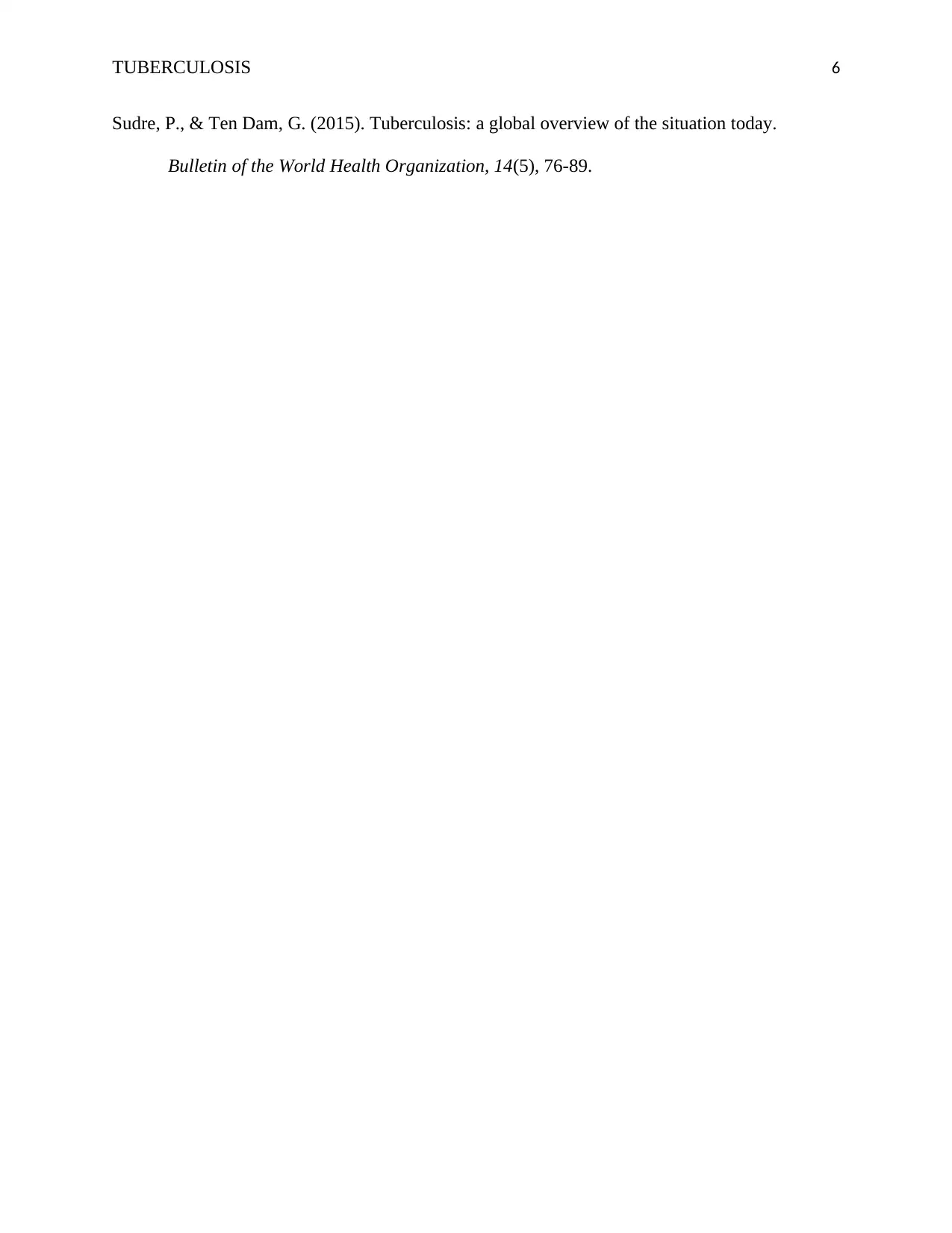
TUBERCULOSIS 6
Sudre, P., & Ten Dam, G. (2015). Tuberculosis: a global overview of the situation today.
Bulletin of the World Health Organization, 14(5), 76-89.
Sudre, P., & Ten Dam, G. (2015). Tuberculosis: a global overview of the situation today.
Bulletin of the World Health Organization, 14(5), 76-89.
⊘ This is a preview!⊘
Do you want full access?
Subscribe today to unlock all pages.

Trusted by 1+ million students worldwide
1 out of 6
Related Documents
Your All-in-One AI-Powered Toolkit for Academic Success.
+13062052269
info@desklib.com
Available 24*7 on WhatsApp / Email
![[object Object]](/_next/static/media/star-bottom.7253800d.svg)
Unlock your academic potential
Copyright © 2020–2025 A2Z Services. All Rights Reserved. Developed and managed by ZUCOL.




